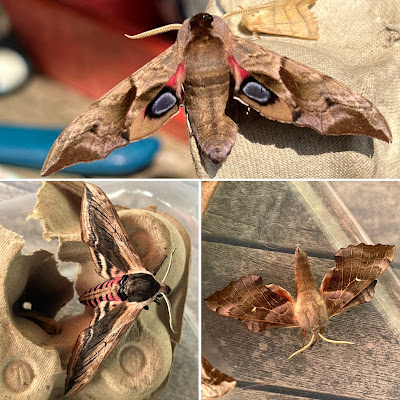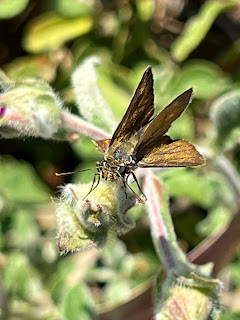Right. After the diversions of our Greek holiday and the Black Hairstreak discovery, it's time to return to the normal subject of this blog, my regular tally of visiting moths. There have been some lovely ones in the last few, warm nights; none new but a great variety and some beautiful species. I'm starting with the Scarlet Tiger, a regular visitor adding colour and fun to the daytime rather than the dark, because it flew unprompted into the house.
Pages
Monday, 19 June 2023
Back to the moths
Sunday, 18 June 2023
Tempted down from the treetops
In early July last year, our local butterfly recorder tipped me off that Black Hairstreaks had been seen in a classic 'butterfly field' a couple of miles from our house, a sunny patch of undisturbed meadow on the edge of dense woodland fringed by blackthorn, brambles and briars. I went and spent a happy morning encountering White Admirals among other butterfly glories and, at the very end of my ramble, found my prey on flowering brambles by a row of run-down garages. Like rare birds, elusive butterflies often find surprising places to tuck themselves away.
 |
| A more typical photo. Black Hairstreaks prefer the treetops where they lick up aphid honey, only making occasional forays down to briars and brambles from late morning |
 |
| The site |
A fortnight ago, the same recorder told me that the 'Black Hairstreak' season for this year had started and could I go and check out the field again for sightings, as she was busy with other demands on her life. I couldn't go immediately because Penny and I were preparing for, doing and recovering from a 20-mile walk in the current blazing sunshine for the charity World Child Cancer which the said cousin chairs. Friendly fate, however, had a treat in store. I took my cousin and her partner for a walk round the 'Big Field', right on our doorstep, and in a sunny woodland ride (second picture above), guess what we saw.
 |
| Same with added bike |
I immediately interrupted our chatter with a schoolmasterly "Shush!" and "Don't move, just for a sec" as an unfamiliar butterfly, reminiscent of a Hedge Brown but smaller and definitely bigger than a Blue, flickered about on blackthorn with sudden, soaring sallies to some young ashes, way beyond my iPhone range. Then down it obligingly came and click! We have a new Black Hairstreak site to add to the 60 or so on record, and it is almost in our garden.
There were two of them on this initial visit and the following day I called by on my bike coming home from Oxford and had ten sightings, sometimes just of one, sometimes of two, but never as close as the first encounter. The picture immediately above was the best I could do. I will keep an eye on them but I am sure, given the mount of blackthorn, briar and bramble we have around here, that there will be other local sites. Butterfly Conservation do well to describe the species as very elusive rather than very rare. There just aren't that many people who know what they are and are looking out for them.
Last year's sighting was followed by my first-ever encounter with a Brown Hairstreak and I described 2022 as an annus mirabilis as a result. I reckon that 2023 has also earned that status now, at least so far as hairstreaks are concerned.
Friday, 16 June 2023
Shiny dung-collector
Tuesday, 13 June 2023
Tomorrow finally comes
Tomorrow and tomorrow and tomorrow... I gaily wrote 'more tomorrow' on my last instalment but here I am five days later, only just getting round to it. Sorry! Diversions have included a wonderful 20-mile walk in aid of the charity World Child Cancer and, just yesterday, the thrill of seeing two Black Hairstreak butterflies less than half-a-mile from our front door. More on that soon (though probably not tomorrow).

We looked more closely and discovered that they were catching moths, extremely deftly with a concentrated look followed by what must have been rapid calculation of height and distance, and then a leap and a swipe with a small paw. Down went the moth and up it was scooped. Crunch! Here's one of the victims, some kind of yellow underwing which was plentiful in the branches of the stunted evergreens.
Thursday, 8 June 2023
Holiday time
No sooner did I stir from my lethargy - or to be fair, business with other things - to post here, than Penny and I were off on holiday in Greece. It was our first long break since before the pandemic and I can much recommend the Southern Peloponnese in the last two weeks in May. We wandered round even grade one, five-star sites such as Mystra, Monemvasia and the Diros caves with very few other visitors.
The wild flowers were still flourishing too, including the lovely Madonna Lily, below, the sort of thing you usually only see at weddings or in flower arrangements in the UK. This one was nonchalantly growing out of a mixture of thin-looking soil, tree-roots and rock on a track down to a beach.
Butterflies always come up to the mark in Greece. They were called 'psyche' in ancient times, a word more famously used for the soul and thence transferred to all the various branches of mental health affairs. In modern Greek they are 'petaloudhi', a pleasant word which means 'something that touches against flowers'. It stands comparison with the French 'papillon', German 'schmetterling' or Spanish 'mariposa'.
My top pictures show two of the best: the 'English' Swallowtail and the Scarce Swallowtail. They were abundant, floating gloriously around, but seldom willing to settle in iPhone photo range. I got just a couple of chances and luckily they paid off. I was lucky, too, to stalk successfully the even more jittery Clouded Yellow shown below. I saw dozens of others but they were always furiously on the move.












































